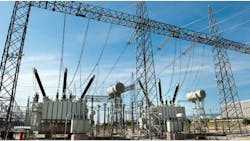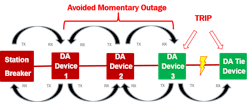Advanced Distribution Protection Increases System Resiliency
As the electric distribution system transforms into a smarter network, Commonwealth Edison Co.’s distribution automation team has embarked on a step-change journey that will transform distribution operations. Engineering personnel with specialized skill sets are advancing distribution grid capabilities through the expansion of distribution automation (DA) and next-generation equipment that supports communication-assisted grid protection and restoration. This advancement in distribution protection philosophy is key to ComEd’s focus on providing a premier customer experience by improving power quality and limiting momentary outages.
Because of the limitations of existing communication systems, DA systems traditionally have relied on time-based coordination between distribution reclosers and substation devices for distribution grid protection functionality. However, DA continues to gain widespread acceptance by moving to a low-latency, high-speed communication network, enabling the deployment of an advanced communication-assisted protection philosophy. This enhances the efficiency of fault identification and isolation by providing greater selectivity in device operation, allowing faster clearing times for fault energy removal and driving down unnecessary momentary outages.
Limitations And Challenges
Historic DA practices rely on time-based protection coordination between devices. Time-based coordination requires the DA recloser time curve to coordinate with the station breaker relaying time curve. Time overcurrent protection typically has the speed needed to isolate distribution faults with minimal damage. However, the problem lies in overcurrent coordination with other downstream devices, which inherently slows down protection. To coordinate, the station breaker relay’s time curve typically is slowed from the pre-distribution automation settings that allow the DA devices to operate faster, isolating faults downstream before the station breaker clears the whole circuit. Although this accomplishes device coordination, it requires a slower trip curve at the station, which creates undesired increased fault times and stress on system components.
To effectively realize the full potential of communication-assisted distribution protection schemes, a couple of essential components are required:
- Protection speed communication network that is accessible to link the DA and substation devices together. Power quality, upstream conductor slap and equipment health from fault stress are all factors to consider when determining a clearing time for faults, which has relay, communication and breaker speed components. For power quality of industrial loads and equipment health, a clearing time of 10 cycles would be ideal. Considering distribution breaker operating times typically are five cycles, this only leaves five cycles for the relaying and communication scheme to operate for the identified fault.
- Common communication protocol to use for communication between devices. The DA devices must be capable of communicating through the selected protocol. The IEC 61850 generic object-oriented substation events (GOOSE) messaging protocol is one of the more effective solutions. A challenge the industry faces is not all manufactured DA devices currently support IEC 61850.
Advanced Protection Scheme
Fiber communication enables DA devices to deploy an advanced protection scheme incorporating the IEC 61850 communication protocol. Use of the GOOSE messaging protocol enables the vendor-agnostic, low-latency transmission of digital data between DA devices and station protection relays. The IEC 61850 standard is a scalable and future-proof solution for DA schemes, which is vital for a sustainable solution. The two focus areas in developing an advanced protection scheme that will provide a significant improvement to the system are as follows:
- Reduction in momentary outages
- Ability to speed up protection set points to remove fault energy from the system faster.
Reduce Momentary Outages
The configuration of distribution protection systems does not allow enough margin to stack multiple distribution recloser time current curves, which is needed for proper coordination. Normally closed reclosers are programmed to operate on the same overcurrent set points, resulting in distribution reclosers overtripping for a fault that ultimately is outside its zone of protection. This creates unnecessary momentary outages for customer segments that are avoidable if these intelligent devices could communicate, in protection speed, with each other.
In developing its communication network, ComEd set a latency requirement of 10 msec as the maximum allowable latency between devices. This communication speed enables an IEC 61850 GOOSE peer-to-peer messaging scheme to be used for improving both protection and restoration efforts. The initial protection use case entailed momentary outage reduction and faster clearing times.
During a fault condition, the expected outcome from the scheme is to isolate the faulted segment with the closest interrupting device and avoid operation of all upstream devices. This avoidance of upstream DA device operations is not accomplished if all reclosers have the same overcurrent curve settings without communication. An IEC 61850 advanced communication-assisted protection scheme results in an avoided momentary outage for customers fed within those segments.
Through IEC 61850, GOOSE messages are transmitted and received in near-real time to ensure proper coordination between the devices. On detection of abnormal current on the line, the devices publish a GOOSE message onto the network to inform subscribers it experienced an overcurrent event. The scheme is set up so that only neighboring devices subscribe to the published message in the normal configuration. This enables the source direction to change, but the scheme remains functional. If an overcurrent condition is detected, the device publishes a block to its adjacent devices:
For all devices except the station breaker:
- If two block signals are received, then do not trip.
- If one block signal is received, then trip.
For the station breaker:
- If one block signal is received, then do not trip.
- If no block signals are received, then trip.
For a normally open tie:
- If the device is open at the time of fault, then no action is required.
- If the device is abnormally closed:
- And two block signals are received, then do not trip.
- And one block signal is received, then trip.
The device settings are created to enable multiple overcurrent elements: one is a communication-supervised fast overcurrent element and the other a non-supervised slow overcurrent element. When the subscribing devices receive a block signal, they restrain operation of the fast overcurrent element. This configuration ensures protection is always enabled, independent of the communication network. For fault-on-fault scenarios, it also ensures an upstream DA device can operate during the fault prior to the substation breaker.
Speed Up Protection
The second focus area in an advanced protection scheme is the ability to speed up protection. As DA devices are installed on the system, it results in having to slow down the protective elements at the substation to ensure proper coordination. This is not ideal but necessary, given the existing communication constraints. With an IEC 61850 communication scheme, it is now possible to communicate directly into the substation, providing the ability to speed up protection.
With GOOSE messages, the fast, supervised element at the substation does not have to follow typical coordination margin principles, because of the substation relay subscribing to its neighboring DA device. On receipt of a block message, the fast element is restrained from operating, which results in significant improvement in speeding up protection on the circuit. For example, a 3000-A fault is cleared 57% faster than with the current communication infrastructure.
This results in fault energy being removed from the system 57% faster, which reduces material failures as cable insulation, transformer windings, conductors, switchgear and other related equipment experience shorter periods of fault current, reducing the stress on that equipment. Communication between the substation DA devices provides additional benefits, specifically regarding advanced restoration efforts.
Next Steps
ComEd’s next steps in deploying an advanced protection scheme is to continue implementing and increasing in-service recloser exposure to gain additional benefits. As devices are operated under fault condition and system conditions provide additional information, schemes will continue to be improved and incorporate lessons learned. In parallel, ComEd will continue to leverage the fiber network for recloser scheme advancement beyond its initial use cases.
Scott Wethy serves on the distribution automation team at Commonwealth Edison.
John Prehn III serves on the distribution automation team at Commonwealth Edison.
Steven Walker serves on the distribution automation team at Commonwealth Edison.
Dale Player serves on the distribution automation team at Commonwealth Edison.
About the Author
Scott Wethy
Scott Wethy ([email protected]), serves on the distribution automation team at Commonwealth Edison.
John Prehn III
John Prehn III ([email protected]), serves on the distribution automation team at Commonwealth Edison.
Steven Walker
Steven Walker ([email protected]), serves on the distribution automation team at Commonwealth Edison.
Dale Player
Dale Player ([email protected]), serves on the distribution automation team at Commonwealth Edison.







